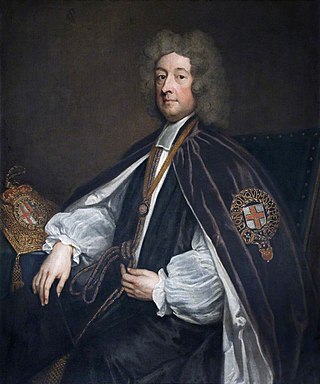Related Research Articles

Thomas Smith (1615–1702) was an English clergyman, who served as Dean of Carlisle, 1672–1684, and Bishop of Carlisle, 1684–1702. He graduated MA from The Queen's College, Oxford in 1639 and served as chaplain to King Charles II.

William Talbot was an English Anglican bishop. He was Bishop of Oxford from 1699 to 1715, Bishop of Salisbury from 1715 to 1722 and Bishop of Durham from 1722 to 1730.
John Travers was an English composer who held the office of Organist to the Chapel Royal from 1737 to 1758. Before filling several parochial posts in London he had been a choir boy at St. George's Chapel, Windsor, and a pupil of Johann Christoph Pepusch.


Richard Willis (1663–1734) was an English bishop.

William Baker was an English churchman and academic, Warden of Wadham College, Oxford, Bishop of Bangor and bishop of Norwich.
William Coward (1648–1738) was a London merchant in the Jamaica trade, remembered for his support of Dissenters, particularly his educational philanthropy.
John Shepreve (1509?–1542) was an English classical scholar and Hebraist.
Henry Hiles was an English composer, organist, writer, and music educator.

Stanton St Bernard is a village and civil parish in the Vale of Pewsey, Wiltshire, England. Its nearest town is Devizes, about 6 miles (10 km) away to the west.
The Tracts for the Times were a series of 90 theological publications, varying in length from a few pages to book-length, produced by members of the English Oxford Movement, an Anglo-Catholic revival group, from 1833 to 1841. There were about a dozen authors, including Oxford Movement leaders John Keble, John Henry Newman and Edward Bouverie Pusey, with Newman taking the initiative in the series, and making the largest contribution. With the wide distribution associated with the tract form, and a price in pennies, the Tracts succeeded in drawing attention to the views of the Oxford Movement on points of doctrine, but also to its overall approach, to the extent that Tractarian became a synonym for supporter of the movement.

Samuel Green (1740–1796) was an English organ builder.
Samuel Thomas (1627–1693) was an English nonjuring clergyman and controversialist.
The Socinian controversy in the Church of England was a theological argument on christology carried out by English theologians for around a decade from 1687. Positions that had remained largely dormant since the death in 1662 of John Biddle, an early Unitarian, were revived and discussed, in pamphlet literature.
Henry Twiselton Elliston, was an English musical composer and inventor.
George England, was an English organ-builder.

The Convocation of 1563 was a significant gathering of English and Welsh clerics that consolidated the Elizabethan religious settlement, and brought the Thirty-Nine Articles close to their final form. It was, more accurately, the Convocation of 1562/3 of the province of Canterbury, beginning in January 1562.

St Mary Magdalene, Richmond, in the Anglican Diocese of Southwark, is a Grade II* listed parish church on Paradise Road, Richmond, London. The church, dedicated to Jesus' companion Mary Magdalene, was built in the early 16th century but has been greatly altered so that, apart from the tower, the visible parts of the church date from the 18th, 19th and early 20th centuries.
References
- ↑ Burchell, David. "Bridge, Richard". Oxford Dictionary of National Biography (online ed.). Oxford University Press. doi:10.1093/ref:odnb/3388.(Subscription or UK public library membership required.)
- . Dictionary of National Biography . London: Smith, Elder & Co. 1885–1900.
- Attribution
![]() This article incorporates text from a publication now in the public domain : "Bridge, Richard". Dictionary of National Biography . London: Smith, Elder & Co. 1885–1900.
This article incorporates text from a publication now in the public domain : "Bridge, Richard". Dictionary of National Biography . London: Smith, Elder & Co. 1885–1900.